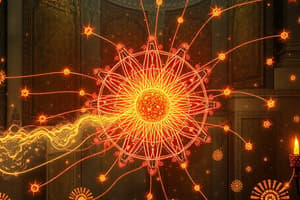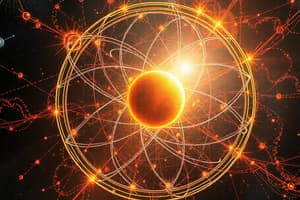Podcast
Questions and Answers
What fundamental change did Rutherford propose in the atomic model in 1911?
What fundamental change did Rutherford propose in the atomic model in 1911?
- He proposed that atoms cannot be divided and are indivisible.
- He suggested that atoms are composed only of electrons and protons.
- He introduced the concept of a dense nucleus surrounded by orbiting electrons. (correct)
- He theorized that electrons are embedded within a positive framework.
Which of the following elements did Rutherford successfully transmute using alpha particles?
Which of the following elements did Rutherford successfully transmute using alpha particles?
- Nitrogen into Oxygen (correct)
- Hydrogen into Helium
- Carbon into Nitrogen
- Oxygen into Carbon
In what year was Rutherford awarded the Nobel Prize in Chemistry?
In what year was Rutherford awarded the Nobel Prize in Chemistry?
- 1920
- 1905
- 1911
- 1908 (correct)
Which types of radiation did Rutherford distinguish during his research?
Which types of radiation did Rutherford distinguish during his research?
Rutherford's famous quote reflects what notable achievement in his research?
Rutherford's famous quote reflects what notable achievement in his research?
What significant discovery did Rutherford make in 1919 related to the composition of atoms?
What significant discovery did Rutherford make in 1919 related to the composition of atoms?
Which university did Rutherford attend on an overseas scholarship to study with J.J. Thomson?
Which university did Rutherford attend on an overseas scholarship to study with J.J. Thomson?
Rutherford's early career opportunity at McGill University was largely due to a recommendation by whom?
Rutherford's early career opportunity at McGill University was largely due to a recommendation by whom?
What was one of the functions of the complex scientific instrument used by Rutherford as depicted in the image?
What was one of the functions of the complex scientific instrument used by Rutherford as depicted in the image?
What was a pioneering achievement by Rutherford concerning the disintegration of elements?
What was a pioneering achievement by Rutherford concerning the disintegration of elements?
Flashcards
Ernest Rutherford
Ernest Rutherford
A prominent physicist known for his work on atomic structure and radioactivity.
Radioactivity
Radioactivity
The emission of radiation from radioactive elements leading to atomic disintegration.
Rutherford model
Rutherford model
Model proposing that atoms have a dense, positively charged nucleus with electrons orbiting.
Nuclear fission
Nuclear fission
Signup and view all the flashcards
Alpha particles
Alpha particles
Signup and view all the flashcards
Nobel Prize in Chemistry
Nobel Prize in Chemistry
Signup and view all the flashcards
Proton discovery
Proton discovery
Signup and view all the flashcards
Disintegration of elements
Disintegration of elements
Signup and view all the flashcards
Rutherford’s Quote
Rutherford’s Quote
Signup and view all the flashcards
Rutherford's Early Life
Rutherford's Early Life
Signup and view all the flashcards
Study Notes
Ernest Rutherford's Contributions to Atomic Theory
- Rutherford transformed our understanding of the atom, identifying its components and revealing its inner structure
- He described two types of radiation: alpha and beta
- Rutherford was born into a farming family in New Zealand
- He won a scholarship to study at Cambridge University
- Thomson recommended Rutherford for a professorship at McGill University in Montreal
- Rutherford's work in Montreal won him the Nobel Prize for his "investigations into the disintegration of the elements"
- He discovered that atoms were not indivisible but contained smaller parts
- He identified alpha and beta radiation, and found that alpha radiation consisted of positively charged particles
- He first achieved the transmutation of the elements by transforming nitrogen atoms into oxygen using alpha particles in a special tube.
- In 1917, Rutherford stated "I have broken the machine and touched the ghost of matter."
Studying That Suits You
Use AI to generate personalized quizzes and flashcards to suit your learning preferences.





